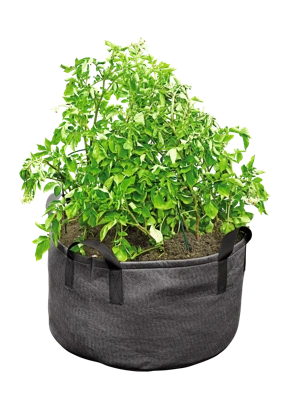Making the Most of Your Potato Harvest
How to choose the best cooking techniques for what you grow
 Freshly harvested potatoes from the Potato Grow Bag.
Freshly harvested potatoes from the Potato Grow Bag.If you had to limit your diet to a single food, potatoes wouldn't be a bad choice. Baked, boiled, chipped, fried, mashed, roasted or scalloped ? the lowly potato can taste completely and deliciously different depending on how it's prepared.
What most folks don't realize is that two different kinds of potatoes prepared in the same way, will often yield completely different results. Bake a Russet Burbank and you'll get a light and fluffy baked potato. Bake a Desiree and you'll have a disappointingly dense and somewhat watery baked potato. Conversely, if you add chunks of Desiree to a pot of soup, they'll hold their shape and have a satisfying waxy texture. Chunks of Russet Burbank will turn to mush and disappear. Both are perfect potatoes. It's all about what happens in the kitchen!
To maximize your potato pleasure, pay attention to the kinds of potatoes you are planting and how each variety should be cooked to its best advantage.
Waxy Texture or Floury Texture?
There are two factors that determine a potato's texture after cooking: its solids content and the type of starch it contains. Whether a potato cooks up moist or dry is determined by its solids content. Potatoes that are low in solids have a moist texture; potatoes that are high in solids are drier. Whether a potato cooks up light and fluffy or dense and waxy, is determined by its starch content. Potatoes that are high in amylose starch are mealy or floury when cooked; potatoes high in amylopectin starch are firm and dense.
The post-cooking texture of different potato varieties can be mapped out on a grid as below (credit for the layout of this map goes to the potato experts at Wood Prairie Farm in Northern Maine):
| Moist > > > > > > > > > > > > > > Dry | |||
|---|---|---|---|
| Soft, moist | Creamy, mid-dry | Mealy, dry | |
| Amylose starch: mealy, floury |
Best cooking technique: steam, saute Best varieties: Cranberry Red |
Best cooking technique: bake, steam, use in soups Best varieties: Rose Gold, Yellow Finn |
Best cooking technique: bake, mash, fry Best varieties: Russet Burbank, Butte |
| Waxy, moist | Waxy, mid-dry | Firm, dry | |
| Amylopectin starch: firm, waxy |
Best cooking technique: boil, use in soup, stews, salads Best varieties: Red Norland, Onaway |
Best cooking technique: all-purpose use, bake, boil, use in salads Best varieties: Caribe, Desiree, Elba |
Best cooking technique: bake, boil, fry Best varieties: Kennebec, Yukon Gold, Bintje, Red Cloud |
More Information
- Keeper Crops: Storing Potatoes, Onions, Garlic and Squash
- An extensive list of more than 50 potato cultivars from Washington State University.
- A list of North American potato varieties and recommended uses from the Oregon State University.
Early or Late — Determinate or Indeterminate?
The time it takes a potato plant to produce mature tubers varies from 70 days to 140 days. As you'd expect, cultivars that produce quickly are referred to as “early” and those that take their time are called “late”.
Early potato varieties are ready to be harvested in 70 to 90 days. Like determinate tomatoes, these plants grow quickly, produce their crop and then die back. Get an early start with an early potato variety, and you'll have ?new? potatoes for summer salads or on the grill. Some readily available early potato varieties are Yukon Gold, Cranberry Red, Reddale, Caribe, Russet Norkotah, Mountain Rose and Onaway.
Midseason potato varieties mature in 90 to 110 days. Popular varieties include Chieftain, Russet Burbank, Red Pontiac, Red Norland, Red Cloud, Desiree, Sangre, Yellow Finn and RoseGold.
Late potato varieties are ready to harvest in 105 to 135 days. Most fingerlings fall into the “late” category. Other late varieties include Elba, Bintje, Carola, German Butterball, Nicola, Butte and All-Blue.
Eat Now or Store for Later?
As is true with other crops, some potato varieties have proved to be excellent winter keepers, while others are best eaten soon after harvest. Though it seems logical that late varieties of potatoes would be better keepers than short-season ones, this is not always the case. Yukon Gold is an example of a good winter keeper that's also an early producer. If you plan to store some of your potatoes for winter eating, seek out cultivars that have a good reputation for long-term storage.
Last updated: 06/22/2023
Print this Article:
Related items
Get the Dirt
Stay up to date on new articles and advice. Please fill out the information below.



